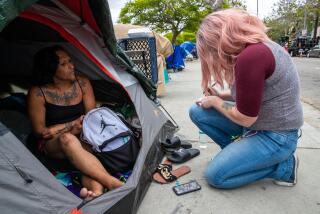Editorial: There is no perfect place for home
Homeless people need housing. On that, nearly everyone can agree. But in the city of Los Angeles, which has expensive real estate and a desperate shortage of affordable housing, where can 28,000 homeless people be settled? In an effort to answer that difficult question, city officials came up this year with 12 unused or underutilized city-owned parcels of land on which housing could be built or which could be sold to buy other property for housing. That’s just a start; ultimately, the goal is to create a minimum of 10,000 units of housing for homeless people.
City officials will have to separate unreasonable NIMBYism from legitimate neighborhood concerns.
But even before the city could issue the official Request for Qualifications to prospective developers, opposition had formed. In Venice, where two of the sites for housing are located, critics contend that one site is inappropriate for a multi-unit development because it sits too close to single-family homes. The second site, located in a neighborhood of multi-unit buildings as well as single-family homes, seems appropriate enough for the neighborhood, but prompted concerns from residents about living next to people suffering from substance addictions. Then there’s also opposition in Venice to situating a storage facility — where homeless people would be allowed to keep their belongings — at the shuttered Westminster Senior Center on Pacific Avenue on the edge of a park. Opponents contend that it’s too close to Westminster Elementary School. Last week, however, the city approved the project anyway.
This is a glimpse of the battles to come. In the months ahead, if elected officials are to fulfill their promises to finally address the region’s homelessness crisis, they will have to muster all their courage to remind constituents that there are no perfect sites for housing. And, what’s more, that the housing that is ultimately built must be spread throughout the city. The homeless cannot be banished exclusively to poor neighborhoods or warehouse districts, even if that would cause fewer political battles.
At the same time, city officials will have to separate unreasonable NIMBYism from legitimate neighborhood concerns. In fact, they should ask themselves some of the same questions in advance that neighbors are sure to ask, and use those as basic criteria for deciding what kind of housing, if any, should be allowed on these sites: Is the proposed project too dense for the neighborhood? Is a neighborhood of mostly single-family homes an appropriate place for a multi-unit development of any kind? Is the city getting the most bang for its buck by putting homeless housing in a particular location — or should it sell that property and invest the money in housing elsewhere?
So far, city officials have pledged to take all those factors into consideration. They also say they will require developers to engage the community, get neighbors’ input on design and size, and be completely transparent about their plans. They should put a high priority on that.
And communities need to remember that these proposed projects are not homeless shelters, where dozens of transient people come and go each day, lining up on the street for hours sometimes in the late afternoon for a meal and a bed and then leaving early the next morning. The city’s new developments may mix housing for homeless people with housing for low-income residents and feature amenities like stores and cafes on their ground floors. The best of the recently constructed apartment buildings for homeless people usually blend into the block — or if they stand out, it’s because they’re better looking than the buildings around them. Consider the PATH Villas at Del Rey or the Gateway Apartments in Marina Del Rey.
Furthermore, studies from different cities over the last couple of decades indicate that, for the most part, new housing developments for homeless people have either no effect on property values or bring them up slightly in the immediate area. That was the conclusion, for instance, of “The Impact of Supportive Housing on Surrounding Neighborhoods: Evidence from New York City,” published in 2008 by the Furman Center at New York University. A study of nine supportive housing developments in various Connecticut cities from 1999 to 2002 found that property values increased around all but one project. True, none of these studies looks at supportive housing in ultra-expensive areas of cities — the areas in New York, in fact, were low-income and poor — because historically they simply haven’t been built there.
Housing must be built and it must be located throughout the city (as the homeless themselves now are). The fact is, homeless people suffering from mental illness or substance addictions — who are only a subset of the total — have more success tackling their problems when they get housing and treatment. That’s not a guarantee that every one of them will conquer their demons if they get a home. But on the streets, they are almost guaranteed never to get better.
Follow the Opinion section on Twitter @latimesopinion and Facebook
More to Read
A cure for the common opinion
Get thought-provoking perspectives with our weekly newsletter.
You may occasionally receive promotional content from the Los Angeles Times.










